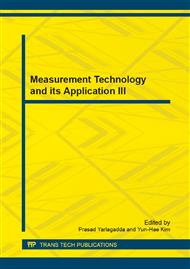[1]
R. Cole,L. Hirschman, L. Atlas,M. Beckman, et al., The challenge of spoken language systems: Research directions for the nineties, IEEE Trans. Speech Audio Process. 1995, 3(1): 1-21.
DOI: 10.1109/89.365385
Google Scholar
[2]
L.R. Rabiner, A tutorial on hidden Markov models and selected applications in speech recognition, Proc IEEE. 1989, 77(2): 257-286.
DOI: 10.1109/5.18626
Google Scholar
[3]
L.R. Rabiner, B.H. Juang, Fundamentals of speech recognition, Prentice-Hall, (1993).
Google Scholar
[4]
Matthew Brand, Nuria Oliver, and Alex Pentland. Coupled hidden Markov models for complex action recognition. In Proc. IEEE Int. Conf. on Computer Vision and Pattern Recognition. 1997, pp.994-999.
DOI: 10.1109/cvpr.1997.609450
Google Scholar
[5]
S.R. Eddy. Profile hidden Markov models. Bioinformatics. 1998, 14(9): 755–763.
DOI: 10.1093/bioinformatics/14.9.755
Google Scholar
[6]
R. Durbin,S. Eddy,A. Krogh, G. Mitchison, Biological sequence analysis. Cambridge University Press, (1998).
Google Scholar
[7]
K. Asai, S. Hayamizu ,K. Handa, Prediction of protein secondary structure by the hidden Markov model, Comput. Appl. Biosci. 1993, 9(2): 141-146.
DOI: 10.1093/bioinformatics/9.2.141
Google Scholar
[8]
J. Kwon and K. Murphy. Modeling freeway traffic with coupled HMMs. Technical report, University of California at Berkeley, May (2000).
Google Scholar
[9]
I. Rezek and S. J. Roberts. Estimation of coupled hidden Markov models with application to biosignal interaction modelling. In Proc. IEEE Int. Conf. on Neural Network for Signal Processing. 2000, volume 2, p.804–813.
DOI: 10.1109/nnsp.2000.890160
Google Scholar
[10]
I. Rezek, M. Gibbs and S. J. Roberts. Maximum a posteriori estimation of coupled hidden Markov models. Journal of VLSI Signal Processing. 2002, 32(1-2): 55-66.
Google Scholar
[11]
Matthew Brand. Coupled hidden Markov models for modeling interactive processes. Technical Report 405, MIT Media Lab, (1997).
Google Scholar
[12]
A. V. Nefian, L. H. Liang, X. X. Liu, X. Pi, C. Mao, and K. Murphy. A coupled HMM for audio-visual speech recognition, in Proc. IEEE ICASSP, 2002, vol. 2, p.2013–(2016).
DOI: 10.1109/icassp.2002.1006167
Google Scholar
[13]
T.T. Kristjansson B.J. Frey, and T. Huang. Event-coupled hidden Markov models. In Proc. IEEE Int. Conf. on Multimedia and Exposition. 2000, vol. 1, p.385–388.
Google Scholar
[14]
Z. Ghahramani and M. I. Jordan. Factorial hidden Markov models. Machine Learning. 1997, 29(2-3): 245–275.
Google Scholar
[15]
Y. Bengio and P. Frasconi. Input-Output HMMs for sequence processing. IEEE Trans. Neural Networks. 1996, 7(5): 1231–1249.
DOI: 10.1109/72.536317
Google Scholar
[16]
R.N. Dave, R. Krishnapuram , Robust clustering methods: a unified view , IEEE Trans. Fuzzy Syst, Vol. 5, No., p.270–293, (1997).
DOI: 10.1109/91.580801
Google Scholar
[17]
Dat Tran and Michael Wagner, Fuzzy hidden Markov models for speech and speaker recognition, in Proc. NAFIPS'99, pp.426-430, USA, (1999).
DOI: 10.1109/nafips.1999.781728
Google Scholar
[18]
J.C. Bezdek, Pattern recognition with fuzzy objective function algorithms, Plenum Press, New York and London, (1981).
Google Scholar
[19]
Dat Tran and Michael Wagner, Fuzzy entropy clustering, the FUZZ-IEEE'2000 Conf., vol. 1, pp.152-158, USA, (2000).
Google Scholar


